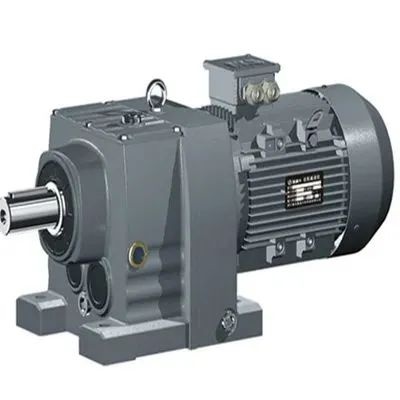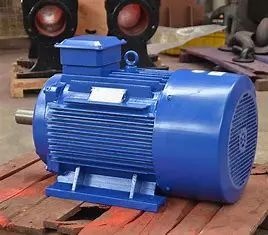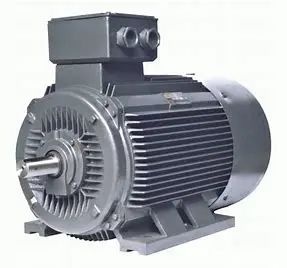The basic elements of motor selection
The basic contents required for motor selection are: driven load type, rated power, rated voltage, rated speed, and other conditions.
one
Type of load driven

Motors can be simply divided into DC motors and AC motors , and AC is further divided into synchronous motors and asynchronous motors.
DC Motor>>>>
Advantages of DC Motors
The speed can be easily adjusted by changing the voltage , and a large torque can be provided . It is suitable for loads that need to adjust the speed frequently , such as rolling mills in steel mills, hoists in mines, etc. But now with the development of frequency conversion technology, the AC motor can also adjust the speed by changing the frequency. However, although the price of variable frequency motors is not much more expensive than ordinary motors, the price of frequency converters occupies a major part of the whole set of equipment, so another advantage of DC motors is that they are cheap .
Disadvantages of DC Motors
The structure is complex. As long as any equipment has a complex structure, it will inevitably lead to an increase in the failure rate. Compared with AC motors, DC motors are not only complicated in windings (excitation windings, commutation pole windings, compensation windings, armature windings), but also add slip rings, brushes and commutators.
Not only the process requirements of the manufacturer are high, but the maintenance cost in the later period is also relatively high. Therefore, in industrial applications, DC motors are in an embarrassing situation where they are gradually declining but still have a place in the transitional stage. If the user has sufficient funds, it is recommended to choose the solution of AC motor with frequency converter. After all, the use of frequency converter also brings many benefits, which will not be discussed in detail.
Asynchronous Motor>>>>
Advantages of asynchronous motors
Simple structure, stable performance, convenient maintenance and low price. And the manufacturing process is also the simplest. I have heard from an old technician in the workshop that it takes two synchronous motors or four asynchronous motors of similar power to assemble a DC motor. Therefore, asynchronous motors are the most widely used in industry.
Asynchronous motors are further divided into squirrel-cage motors and wound motors , the difference being the rotor. Squirrel-cage motor rotors are made of metal strips, either copper or aluminum. The price of aluminum is relatively low, and my country is a big country of aluminum ore, which is widely used in occasions with low requirements. But copper has better mechanical and electrical properties than aluminum, and most of the rotors I've come into contact with are copper rotors. After the squirrel cage motor solves the problem of disconnection in the process, the reliability is far higher than that of the winding rotor motor.
Disadvantages of asynchronous motors
The torque obtained by the metal rotor cutting the magnetic field lines in the rotating stator magnetic field is small, and the starting current is large, so it is difficult to handle the load that requires a large starting torque. Although more torque can be obtained by increasing the length of the motor core, the power is very limited.
The winding type motor energizes the rotor winding through the slip ring when it is started to form the rotor magnetic field, which moves relative to the rotating stator magnetic field, so the torque is greater. And in the starting process, the water resistance is connected in series to reduce the starting current, and the water resistance is controlled by a mature electronic control device to change the resistance value with the starting process.
For rolling mills, hoists and other loads. Compared with the squirrel cage motor, the wound asynchronous motor adds slip rings, water resistance, etc., and the overall equipment price has a certain increase. Compared with the DC motor, the speed regulation range is relatively narrow and the torque is relatively small, and the corresponding value is also low.
Synchronous motor>>>>
In addition to the overexcitation state that can compensate for reactive power, the advantages of synchronous motors include:
1) The speed of the synchronous motor strictly follows n=60f/p, which can precisely control the speed;
2) The operation stability is high. When the grid voltage suddenly drops, the excitation system will generally force the excitation to ensure the stable operation of the motor, while the torque of the asynchronous motor (proportional to the square of the voltage) will drop significantly;
3) The overload capacity is larger than the corresponding asynchronous motor;
4) High operating efficiency, especially for low-speed synchronous motors.
Synchronous motors cannot be started directly, and need to be started asynchronously or with variable frequency. Asynchronous start means that the synchronous motor is equipped with a start winding similar to the cage winding of the asynchronous motor on the rotor, and an additional resistance about 10 times the resistance value of the excitation winding is connected in series in the excitation circuit to form a closed circuit, and the stator of the synchronous motor is directly connected. The power grid, so that it is started as an asynchronous motor. When the speed reaches the sub-synchronous speed (95%), the starting method of cutting off the additional resistance; frequency conversion starting is not repeated. So one of the disadvantages of synchronous motors is the need to add additional equipment for starting .
Synchronous motors run on excitation current, and if there is no excitation, the motor is asynchronous. The excitation is a DC system applied to the rotor, and its rotation speed and polarity are consistent with the stator. If there is a problem with the excitation, the motor will lose its step and cannot be adjusted, triggering the protection "excitation fault" The motor trips.
Therefore, the second disadvantage of the synchronous motor is that it needs to increase the excitation device, which was directly supplied by the DC machine in the past, but is now mostly supplied by the thyristor rectifier. As the old saying goes, the more complex the structure and the more equipment, the more failure points and the higher the failure rate.
According to the performance characteristics of synchronous motors, their applications are mainly on loads such as hoists, mills, fans, compressors, rolling mills, and water pumps.
To sum up, the principle of selecting a motor is that on the premise that the performance of the motor meets the requirements of the production machinery, the motor with simple structure, low price, reliable operation and convenient maintenance is preferred .
two
Amount of power

The rated power of the motor refers to the output power , that is, the shaft power , also known as the capacity, which is the iconic parameter of the motor. People often ask how big the motor is. Generally, it does not refer to the size of the motor, but to the rated power . It is the most important indicator to quantify the motor's drag load capacity, and it is also the parameter requirements that must be provided when the motor is selected .
(For rated power, for rated voltage, for rated current, cosθ is power factor, η is efficiency)
The principle of correctly selecting the motor capacity should be the most economical and most reasonable decision on the power of the motor under the premise that the motor can meet the requirements of the production mechanical load . If the power is too large, the equipment investment will increase, causing waste, and the motor often runs under load, and the efficiency and power factor of the AC motor are low; on the contrary, if the power is too small, the motor will be overloaded, causing the motor to run prematurely. damage.
three
rated voltage

The rated voltage of the motor refers to the line voltage in the rated working mode .
The choice of the rated voltage of the motor depends on the power supply voltage of the power system to the enterprise and the size of the motor capacity.
The choice of AC motor voltage level mainly depends on the power supply voltage level of the place of use. Generally, the low voltage network is 380V, so the rated voltage is 380V (Y or △ connection), 220/380V (△/Y connection), and 380/660V (△/Y connection). When the power of the low-voltage motor increases to a certain extent (such as 300KW/380V), it is difficult to increase the current due to the limitation of the carrying capacity of the wire, or the cost is too high.
It is necessary to achieve high power output by increasing the voltage. The power supply voltage of the high-voltage grid is generally 6000V or 10000V, and there are also voltage levels of 3300V, 6600V and 11000V abroad. The advantage of the high-voltage motor is that it has high power and strong impact resistance; the disadvantage is that the inertia is large, and it is difficult to start and brake.
The rated voltage of the DC motor should also match the power supply voltage. Generally 110V, 220V and 440V. Among them, 220V is a common voltage level, and high-power motors can be increased to 600-1000V. When the AC power supply is 380V and the three-phase bridge thyristor rectifier circuit is used for power supply, the rated voltage of the DC motor should be 440V. When the three-phase half-wave thyristor rectifier power supply is used for power supply, the rated voltage of the DC motor should be 220V.
Four
Quota speed
The rated speed of the motor refers to the speed in the rated working mode.
The motor and the working machinery driven by it have their own rated speed. When choosing the speed of the motor, it should be noted that the speed should not be too low, because the lower the rated speed of the motor, the more series, the larger the volume, and the higher the price; at the same time, the speed of the motor should not be too selected. high, as this would make the transmission too complex and difficult to maintain.
In addition , when the power is constant, the motor torque is inversely proportional to the speed .
Therefore, those with low requirements for starting and braking can comprehensively compare several different rated speeds from the aspects of initial investment, floor space and maintenance costs, and finally determine the rated speed; while frequent starting, braking and reversing, However, if the duration of the transition process has little effect on the productivity, in addition to considering the initial investment, the speed ratio and the rated speed of the motor are mainly selected on the condition of the minimum amount of loss in the transition process. For example, the hoist motor needs frequent forward and reverse rotation and has a large torque, so the speed is very low, the motor is bulky and expensive.
When the motor speed is high, the critical speed of the motor also needs to be considered . The rotor of the motor will vibrate during operation, and the amplitude of the rotor increases with the increase of the speed. When it reaches a certain speed, the amplitude reaches the maximum value (that is, the resonance is usually called). After this speed, the amplitude increases with the speed. It gradually decreases and stabilizes within a certain range. The rotational speed with the largest rotor amplitude is called the critical rotational speed of the rotor.
This rotational speed is equal to the natural frequency of the rotor. When the speed continues to increase, the amplitude will increase again when it is close to 2 times the natural frequency. When the speed is equal to 2 times the natural frequency, it is called the second-order critical speed, and by analogy, there are third-order and fourth-order critical speeds. If the rotor runs at a critical speed, severe vibration will occur, and the bending degree of the shaft will increase significantly. Long-term operation will also cause serious bending deformation of the shaft, or even breakage.
The first-order critical speed of the motor is generally above 1500 rpm, so conventional low-speed motors generally do not consider the influence of the critical speed. On the other hand, for a 2-pole high-speed motor, the rated speed is close to 3000 rpm, and this influence needs to be considered, and it is necessary to avoid using the motor in the critical speed range for a long time.
Generally speaking, the motor can be roughly determined by providing the type of load driven, the rated power, rated voltage, and rated speed of the motor. However, these basic parameters are far from sufficient if the load requirements are to be optimally met. Parameters that also need to be provided include: frequency, working system, overload requirements, insulation class, protection class, moment of inertia, load resistance torque curve, installation method, ambient temperature, altitude, outdoor requirements, etc., which are provided according to specific conditions.



























 XINDA
XINDA